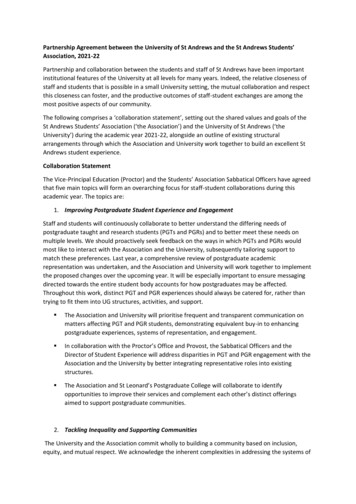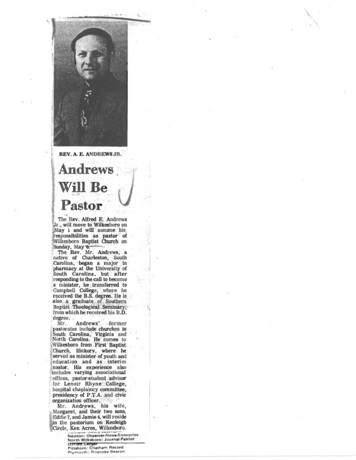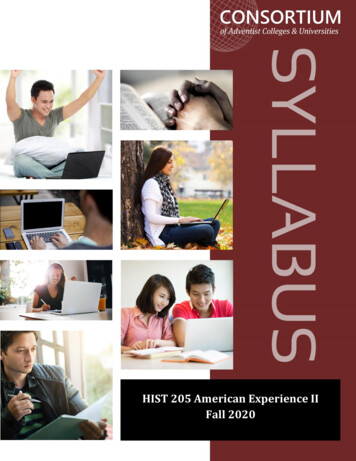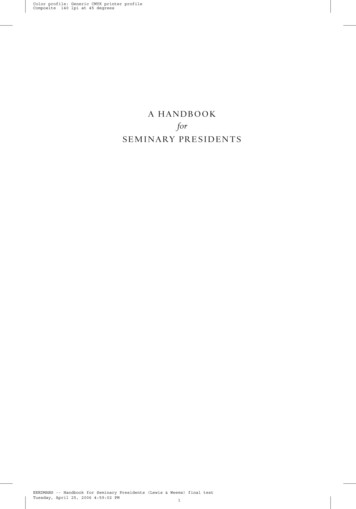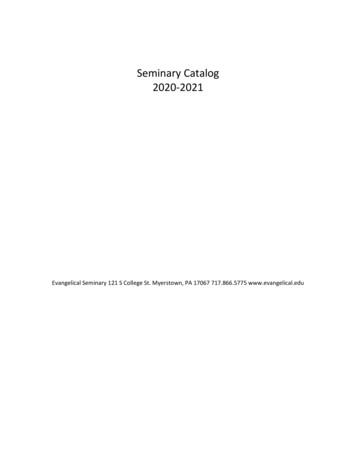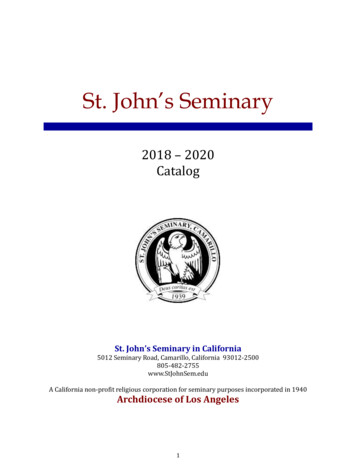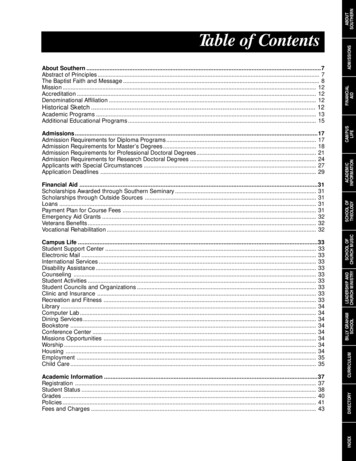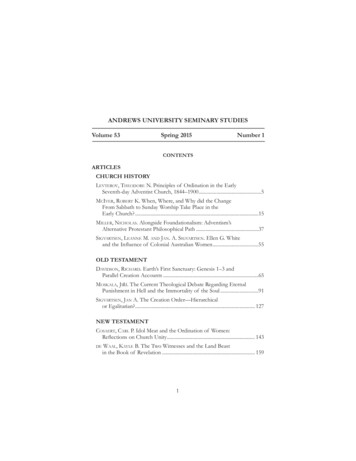
Transcription
ANDREWS UNIVERSITY SEMINARY STUDIESVolume 53Spring 2015Number 1CONTENTSARTICLESCHURCH HISTORYLEVTEROV, THEODORE N. Principles of Ordination in the EarlySeventh-day Adventist Church, 1844–1900 .5MCIVER, ROBERT K. When, Where, and Why did the ChangeFrom Sabbath to Sunday Worship Take Place in theEarly Church? .15MILLER, NICHOLAS. Alongside Foundationalism: Adventism’sAlternative Protestant Philosophical Path .37SIGVARTSEN, LEANNE M. AND JAN. A. SIGVARTSEN. Ellen G. Whiteand the ,nÁuence of Colonial Australian Women .55OLD TESTAMENTDAVIDSON, RICHARD. Earth’s First Sanctuary: Genesis 1–3 andParallel Creation Accounts .65MOSKALA, JIĝÍ. The Current Theological Debate Regarding EternalPunishment in Hell and the Immortality of the Soul .91SIGVARTSEN, JAN A. The Creation Order—Hierarchicalor Egalitarian?. 127NEW TESTAMENTCOSAERT, CARL P. Idol Meat and the Ordination of Women:ReÁections on Church 8nity. 143DEWAAL, KAYLE B. The Two Witnesses and the Land Beastin the Book of Revelation . 1591
2SEMINARY STUDIES 53 (SPRING 2015)MISSIONSBAUER, BRUCE AND BOUBAKAR SANOU. Cultural Considerationsand Women’s Ordination . 175ONONGHA, KELVIN. Tentmaking in the Twenty-First Century:Theological and Missiological Implications forContemporary Adventist Missions . 183THEOLOGYWHIDDEN, WOODROW. The Triumph of God’s Love: The OptimisticTheological Theodicy of Ellen G. White. 197BOOK REVIEWSAllison Jr., Dale. C. A Critical and Exegetical Commentary on theEpistle of James. (PEDRITO MAYNARD-REID) . 215Bergmann, Michael, Michael J. Murray, and Michael C. Rea, eds.Divine Evil?: The Moral Character of the God of Abraham.(IRIANN IRIZARRY) . 216Cameli, Louis J. Catholic Teaching on Homosexuality:New Paths to Understanding (DAVID PENNO) . 218Kalimi, Isaac, and Seth Richardson, eds. Sennacherib at the Gatesof Jerusalem: Story, History and Historiography. (TARSEE LI) . 222Lamb, David A. Text, Context and the Johannine Community.A Sociolinguistic Analysis of the Johannine Writings.(IGOR LORENCIN). 224Lederach, J. P. 5econcile: ConÁict Transformation for 2rdinary Christians.(STANLEY PATTERSON). 226Poirier, Timothy L. ed. Roland Karlman, annotator. The Ellen G. WhiteLetters & Manuscripts with Annotations, 1845-1859. Volume 1.(MICHAEL W. CAMPBELL) . 228Rice, Richard. Suffering and the Search for Meaning: ContemporaryResponses to the Problem of Pain. (IRIANN IRIZARRY). 233Seifrid, Mark A. The Second Letter to the Corinthians.(PANAYOTIS COUTSOUMPOS) . 235Strayer, Brian E. J. N. Loughborough: The Last of the AdventistPioneers. (MICHAEL W. CAMPBELL). 237Vance, Donald A., George Athas, and Yael Avrahami.Biblia Hebraica Stuttgartensia: A Reader’s Edition.(OLIVER GLANZ). 240
TABLE OF CONTENTS3Wilson, Brian C. Dr. John Harvey Kellogg and the Religionof Biologic Living. (KEVIN BURTON). 244************The articles in this journal are indexed, abstracted, or listed in: Elenchus ofBiblica: Internationale Zeitschriftenschau für Bibelwissenschaft und Grenzgebiete; NewTestament Abstracts; Index Theologicus Zeitschrifteninhaltsdienst Theologie; 2ldTestament Abstracts; 2rientalistische Literaturzeitung; Religion Index 2ne, Periodicals;Religious and Theological Abstracts; Seventh-day Adventist Periodical Index; TheologischeZeitschrift; Zeitschrift für die alttestamentliche Wissenschaft.Copyright 2015 by Andrews 8niversity PressISS1 0003-2980
Andrews University Seminary Studies, Vol. 53, No. 1, 5-13.Copyright 2015 Andrews University Seminary Studies.PRINCIPLES OF ORDINATION IN THE EARLYSEVENTH-DAY ADVENTIST CHURCH,1844-1900THEODORE N. LEVTEROVLoma Linda UniversitySeventh-day Adventists began to practice the ritual of ordination even beforetheir ofÀcial organi]ation in 1 3. 7he issue did not stir any controversieswithin the denomination until several decades ago when the question ofwomen’s ordination arose. Many opinions have been expressed on both sidesof the issue, as authors have tried to defend their positions from the Bibleand the writings of Ellen G. White. Few, however, have asked the question:What were the guiding principles and motivations that prompted the earlySabbatarian and Seventh-day Adventist leaders to begin to ordain people toministries" 7he purpose of this study, therefore, is to examine and analy]ethree broad reasons that guided early Adventist practices of ordination. 7heessay will Ànish with short concluding remarks.The Beginning of Ordination as Practical Necessity7he Sabbatarians later Seventh-day Adventists did not doubt the biblicalvalidity of ordination from the very beginning of their existence. 7hey believedthat the practice was rooted in the New 7estament and played a necessaryrole within the early Christian church.1 Beyond that, James White and JosephBates, two of the founders of the Sabbatarian movement, had been ordainedby their Christian denomination before they became Adventists. 7herefore,the earliest discussions and practices of ordination within the Sabbatarianmovement did not come as a result of theological controversies, but ratherbecause of pragmatic and ecclesiastical necessities.7he Àrst substantial discussion of ordination among Sabbatarians beganduring the 1 50s when the movement had experienced rapid growth. 7hegrowth brought its own challenges, however. Since the movement lacked anykind of organi]ation, believers were open to various fanatical teachings andextreme views prevalent at that time.2 Anybody, for example, could claim tobe an Adventist minister, as there was not a system by which to check one’scredibility. Moreover, since 1 53, the Sabbatarians had dealt with the Àrstoffshoots, the “Messenger party,” and the “Age to Come” movements, thatcame out from their midst. 7he Messengers also started to publish the ÀrstJames White, “Gospel Order,” Review and Herald, 'ec. 20, 1 53, 1 -1 J. B.Frisbie, “Church Order,” RH, Jan. , 1 55, 153-155 J. . Waggoner, The Church: ItsOrganization, Ordinances, and Discipline Oakland, CA: 3aciÀc 3ress, 1 , 15-1 J. N.Loughborough, The Church: Its Organization, Order, and Discipline Washington, 'C:5eview and erald, 1 0 , - 1.1George R. Knight, A Brief History of Seventh-day Adventists agerstown, M':Review and erald, 1 , 5 - 0.25
SEMINARY STUDIES 53 (SPRING 2015)periodical against the Sabbatarians as they questioned some of their majorteachings.3 It is in this context that James and Ellen White began to discussthe necessity for more formal organi]ation and the need for a recogni]edministry.On 'ecember , 1 53, James White wrote that gospel order had been“much neglected, and that the attention of the church should be turnedto this subject. . . .”4 7wo weeks later he noted further that “gospel order”included the ordination of ministers and gave three main reasons for that.First, the ordained ministers would know that they had “the sympathy of[the] ministering brethren and of the church.” Second, it would be a vehicleto “unite the people of God.” And third, it would “shut a door again Satan”and the “inÁuence of false teachers.”57he same year Ellen White wrote in a similar tone:7he Lord has shown that gospel order has been too much feared andneglected. Formality should be shunned but, in so doing, order shouldnot be neglected. 7here is order in heaven. 7here was order in the churchwhen Christ was upon the earth, and after is departure order was strictlyobserved among is apostles. And now in these last days, while God isbringing is children into the unity of the faith, there is more real need oforder than ever before for, as God unites is children, Satan and his angelsare very busy to prevent this unity and to destroy it. . . . Men whose lives arenot holy and who are unTualiÀed to teach the present truth enter the Àeld without EeingacNnowledged Ey the church or the Erethren generally, and confusion and disunion arethe result. 7he solution, she noted, was to have recogni]ed ministers set apart by layingon of hands. Other Sabbatarians began to express the same relationship between“gospel order” and ordination. J. B. Frisbie, for example, wrote that “gospelorder in the ministry” was that “which will bring us into the unity of thefaith, and cause the watchmen to see eye to eye.” R. F. Cottrell also notedthat the “order in the Church of God has been vindicated by different writersin the Review [sic], and has been established to a considerable extent by theordination of ofÀcers in the churches.” Not surprisingly, the Sabbatariansbegan to ordain their ministers in the beginning of 1 50s.107heodore N. Levterov, “7he 'evelopment of the Seventh-day AdventistUnderstanding of Ellen G. White’s 3rophetic Gift, 1 44-1 ” 3h' diss., AndrewsUniversity, 2011 , 1- 3.3James White, “Gospel Order,” RH, 'ec. , 1 53, 1 3.4James White, “Gospel Order,” RH, 'ec. 20, 1 53, 1 -1 .Ellen G. White, Early Writings agerstown, M': Review and erald, 2000 , emphasis supplied. Ibid., 101. J. B. Frisbie, “Church Order,” RH, Jan. , 1 55, 154.R. F. Cottrell, “What are the 'uties of Church OfÀcers"” RH, Oct. 2, 1 5 , 1 3.5 Loughborough, The Church, 100-102.10
PRINCIPLES OF ORDINATION . . . At the same time, the Sabbatarians also began to raise questions aboutthe practical necessity of ordaining local ofÀcers to serve the Sabbatarianchurches. In 'ecember 1 53 . S. Gurney wrote that the churches inFairhaven and Dartmouth, Massachusetts, decided to select two brethren, “toact the part of ‘deacons,’ as denominated in the Bible.” Since Sabbatarianministers had been “called to travel,” and believers had been deprived of theLord’s Supper, he reasoned, “it seemed proper to set apart some one in thechurch for the purpose of more fully maintaining Gospel Order.”11In January 1 55 John Byington wrote to the Review that many of theSabbatarian churches were in a “distracted and discouraged condition.” e,therefore, wondered if elders and deacons should be appointed in “everychurch.” James White replied that the Bible supported the establishment ofsuch ofÀces. Based on Acts 14:21-23 and 7itus 1:5-1 , he believed that sincethe early church ordained local ofÀcers, they were also needed in the “lastdays” to prevent “confusion,” “disorder,” or “unscriptural notions.” e alsourged the brethren to “express their opinion on the subject.”12In January 1 55 J. B. Frisbie published an article to explain the issuefurther. e noted that in the New 7estament there were two kinds of“preaching elders.” One, the “evangelical or travelling elders or bishops,”such as Silas, 7imothy, 7itus, and 3aul, who were responsible for the “careof all the churches” and two, those who “had the pastoral care and oversightof one church.” 7heir primary role was to “administer all the ordinances ofthe church of God on earth. Matt. xxviii:1 ” and to look after “the spiritualaffairs of the church.” On the other hand, there was the ofÀce of the deaconsto take care of the “temporal affairs of the church essential to its prosperity. . . .”13 Interestingly, Frisbie expanded his position a year later, andnoted that the early church also had deaconesses who served the local churchand “‘were ordained to their ofÀce by the imposition of the hands of thebishop. . . .’”14 It seems, however, that the early Sabbatarians did not followFrisbie’s reasoning and did not ordain deaconesses, at least initially.7he reluctance to ordain deaconesses, however, appears to have beenmore a cultural than a biblically based decision, as later references show.In 1 3 W. . Littlejohn, for instance, acknowledged that the existence ofdeaconesses in the apostolic days was “highly probable.” And while someSeventh-day Adventist churches had the custom “to elect one or morewomen to Àll a position similar to that which it is supposed that 3hoebe andothers occupied in her day,” it had not been “the custom with us [Seventh-dayAdventists] to ordain such women.” 7he same was true with women being . S. Gurney, “From Bro. Gurney,” RH, Dec. 2 , 1 53, 1 .James White, “Church Order,” RH, Jan. 23, 1 55, 1 4.13J. B. Frisbie, “Church Order,” RH, Jan. , 1 55, 154-155.14J. B. Frisbie, “Deacons,” RH, July 31, 1 5 , 102. Frisbie cited an extract fromAdam Clarke’s commentary.1112
SEMINARY STUDIES 53 (SPRING 2015)or acting as elders.15 7hus by the 1 0s the Sabbatarians had begun to ordainministers, elders, and deacons, and were happy with the results.By 1 3, when the Seventh-day Adventist Church was ofÀciallyestablished, the ordination practices were well in place, although questionsrelated to ordination and its practical application continued to be examinedand discussed.1 One can argue, therefore, that a major principle that guidedthe practice of ordination among the early Sabbatarians was based on thepractical needs of the church rather than theological rationale.Ordination as PuElic Recognition of Divine AppointmentA second general principle recogni]ed by the Seventh-day Adventist Churchwas the belief that ordination was Àrst and foremost a calling from God,while the ordination ritual itself was a simple conÀrmation of that calling.7hus ordination was related to the spiritual gifts that God gave to people inthe church.In 1 5 J. B. Frisbie wrote that “the power and authority to ordain eldersor bishops in the church came from the oly Spirit of God.” 7he laying onof hands, on the other hand, did not bring any “higher power,” but was “theseparating act by which the grace of God was imparted.”1 Ellen White alsoagreed that those who had “given full proof that they have received theircommission of God” were to be set apart “to devote themselves entirely to is work” by ordination.1 G. I. Butler similarly explained that ordinationwas “simply an outward ceremony by which a body of believers set apart orinstalled a person into some ofÀcial position, as that of minister, local elder,or deacon.” Using the example of 3aul and Barnabas, he noted that it was the oly Spirit who called them Àrst, after which the people simply acknowledgedtheir ministry by laying “hands on them.”1 Uriah Smith, likewise, noted thatthe authority of the gospel minister rests upon a divine call to the work,and if he has not such a call, he has no authority to preach the gospel, nomatter how many hands have been laid upon him, nor how pompous theceremony of ordination performed over him. Christ can give authority tomen to preach his gospel, as well in the nineteenth century as in the Àrst. . . .So we say, again, that they have authority to preach whom the Lord calls tothe work. If it is asked, why then have any outward ceremony of ordinationat all, a sufÀcient answer is found in the fact that such a service gives unity15W. . Littlejohn, “7he Church Manual,” RH, July 3, 1 3, 42 emphasissupplied idem, “7he Duties of Local Church OfÀcers,” RH, Nov. 22, 1 , 30.1 Some points of discussion were: reelection and re-ordination of ofÀcers, thevalidity of one’s ordination in case of moving to a different church, the validity ofordination of ministers and elders coming from other denominations the proper payof ministers, and others.1 J. B. Frisbie, “Church Order,” RH, June 2 , 1 5 , 0.1 Ellen G. White, Early Writings, 101.1G. I. Butler, “Ordination,” RH, Feb. 13, 1 , 50-51.
PRINCIPLES OF ORDINATION . . .to the work, and is a means by which the church can show its acquiescencein, and its harmony with, what they consider the divine will.20Despite that belief, however, promising young people were initially issuedlicenses and went through a “trial” period in order to show their “Àtness forthe work” and to give evidence that they were “called of God to that service.”21After an individual had worked for one or more years “acceptably,” it was“customary for the State Conference to ordain him and give him credentials,and a certiÀcate of ordination.”22 7his method seemed to work well. In 1 G. I. Butler, the president of the Michigan Conference at that time, reportedthat they had received “quite a number of applications for labor in churchesin various places” for consideration.237he ordination service usually resembled the order of the 3rotestanttradition. It was usually performed by several ordained ministers and includeda sermon, a prayer with laying on of hands , and a charge to the ordained.24An interesting detail, however, was the greeting of the ordained with a “holykiss” by the ofÀciating pastors at the end of the service to welcome them tothe gospel ministry.25 7hus, the ordination procedures among Seventh-dayAdventists, with few exceptions, have not changed substantially through theyears.Early ordination services also seemed to be highly emotional andcharismatic. 7he presence of the oly Spirit was seen as an approval of theordained. In 1 1, for example, A. S. utchins reported that at the ordinationof brother D. 7. Bourdeau “the oly Spirit fell sweetly and powerfullyupon us, manifestly approving of the solemn and important step.” Afterhis ordination, Bourdeau bapti]ed ten people.2 At the ordination of churchofÀcers in Indiana, S. . Lane wrote: “7he blessing of the Lord rested uponus, and as one after another testiÀed of their love for the truth nearly all inthe house were moved to tears and some wept aloud.”2 At another ministerialordination, that of Brother Nettleton, G. I. Butler testiÀed that “the Lord’sSpirit came in and witnessed to the act, as it seemed to us all. Many were intears, and a very tender, precious inÁuence affected the hearts of all. Andso our meeting closed, and the brethren and sisters went to their homesencouraged.”2 7hus Seventh-day Adventists saw ordination to ministriesUriah. Smith, “In the Question Chair,” RH, Oct. 20, 1 1, 4 .Uriah. Smith, “7o Correspondents,” RH, June 2 , 1 , 4 Waggoner, TheChurch, 1 .22W. . Littlejohn, “7he Church Manual,” RH, Sept. 11, 1 3, 5 .23G. I. Butler, “Work in Michigan,” RH, Dec. 21, 1 , 3.202124See, for example: Uriah Smith, “7he Conference,” RH, Oct. 1 , 1 , 124James White, “Meeting at Oakland,” RH, Apr. 11, 1 , 112.25“7he Church Manual,” RH, July 1 , 1 3, 45 -45 .2 A. S. utchins, “Report of Meetings,” RH, June 25, 1 1, 40.2 S. . Lane, “Indiana,” RH, Mar. 4, 1 5, .2 G. I. Butler, “7he Nebraska Camp-Meeting,” RH, Oct. 11, 1 1, 23 .
10SEMINARY STUDIES 53 (SPRING 2015)as being a calling from God and the ordination ceremony as the outwardconÀrmation of that calling.Ordination and )ulÀlling the *reat CommissionA third general principle that guided ordination in Seventh-day Adventismwas related to the fulÀllment of the mission of the church. Although thesmall Sabbatarian group initially believed in the “shut door”2 theory, by thebeginning of 1 50s they reali]ed that they had a message to share with others.307he ritual of ordination, consequently, began to be seen as an integral part ofthe fulÀllment of that mission.As the church grew through the years and its mission expanded, thedemand for more workers and missionaries became obvious. By the 1 0sand beyond, Seventh-day Adventists began to urge people, especially youngmen and women, to get educational training and become involved in the workof the church. It is in this context that Adventists began to consider theparticipation of women in ministry of various kinds.An interesting accident happened in 1 . James White reported thathe ordained “Bro[ther] and sister Strong” to the ministry by “prayer and thelaying on of hands.” “I mention the name of sister Strong on this occasion,”he explained, because “my views and feelings are that the minister’s wifestands in so close a relation to the work of God . . . that she should, inthe ordination prayer, be set apart as his helper.”31 In 1 0 the “Minister’sLecture Association” offered a series of trainings for ministers. Both menand women were invited to enroll. 7he price of membership was “ 5 formen and 3 for women.”32 In 1 James White also wrote an article entitled“Women in the Church,” aiming to explain 1 Cor 14: 34-35 “Let your womenkeep silent in the churches. . . .” . Among other arguments, White noted that“in the sacred Scriptures of the Old and New 7estaments, holy women heldpositions of responsibility and honor” and defended their full participation inthe work of the church.33 Similar articles continued to appear in the Adventistpublications.34Ellen White similarly urged the participation of women in the work ofthe church. “Women who can work are needed now,” she wrote in 1 ,“women who are not self-important, but meek and lowly of heart, who willwork with the meekness of Christ wherever they can Ànd work to do for the7he belief that no more people could be saved after October 22, 1 44.James White, “Call at the arbinger OfÀce,” RH, Feb. 1 , 1 52, 5.230James White, “Report from Bro. White,” RH, Aug. 13, 1 , 13 .James White, “Minister’s Lecture Association,” RH, Jan. 10, 1 0, 32.33James White, “Women in the Church,” RH, May 2 , 1 , 1 2.34Some examples are: “Shall Women Speak in the Church?” RH, Mar. 14, 1 1,J. . Waggoner, “Woman’s 3lace in the Gospel, ST, Dec. 1 , 1 , 3 0 N. J.Bowers, “May Women 3ublicly Labor in the Cause of Christ?” RH, June 14, 1 1,3 2-3 3.3132
PRINCIPLES OF ORDINATION . . .11salvation of souls.”35 In 1 5 she also speciÀcally noted that women shouldbe ordained for speciÀc ministries. 7he context of her article clearly showsher concern with the noninvolvement of church members in the work ofthe church. “7he burden of church work should be distributed among itsindividual members,” she wrote, “so that each one may become an intelligentlaborer for God. 7here is altogether too much unused force in our churches.”3 She then urged leaders to involve every member, including women, in thework. As she put it:Women who are willing to consecrate some of their time to service ofthe Lord should be appointed to visit the sick, look after the young, andminister to the necessities of the poor. 7hey should be set apart to this workEy prayer and laying on of hands. . . . 7his is another means of strengtheningand building up the church. We need to branch out more in our methodsof labor. Not a hand should be bound, not a soul discouraged, not a voiceshould be hushed let every individual labor, privately or publicly, to helpforward this grand work.3 Whatever interpretation one may make of the above paragraph, Ellen Whiteclearly indicated that ordination was appropriate for women who were willingto be involved in some capacity in the ministry of the church. 7hus shebroadened the concept of ordination and its true meaning. Ordination, in hermind, was not limited in scope as only belonging to men.In 1 Ellen White again asserted that women “should labor in thegospel ministry,” since there were situations where “they would do moregood than the ministers who neglect to visit the Áock of God.”3 Intriguingly,7he Review and the Signs of the Times also began to report speciÀc “religiousnews” of ordination of women among other Christian denominations.3 Notsurprisingly, we Ànd that since the 1 0s women began to be much moreinvolved within the Seventh-day Adventist Church and its mission.407he high point for women in ministry, however, came at the GeneralConference meeting in 1 1. 3rompted by the belief that all members wereto participate in the mission of the church, the General Conference issuedan ofÀcial resolution stating that “females possessing the necessary TualiÀcations toÀll that position, may, with perfect propriety, Ee set apart Ey ordination to the work ofEllen G. White, “Address and Appeal, Setting Forth the Importance ofMissionary Work,” RH, Jan. 2, 1 , 1.35Ellen G. White, “7he Duty of the Minister and the 3eople,” RH, July , 1 5,3 433.Ibid., 434 emphasis supplied.Ellen G. White, “7he Laborer Is Worthy of is ire,” MS 43a, 1 , RC,3 3 LLU.3“Religious [Notes],” ST, Sep. 11, 1 4, 55 “Religious [Notes],” RH, Feb. 2 ,1 3, 143.40For a list of Seventh-day Adventist women in ministry see: Josephine Benton,Called Ey *od: Stories of Seventh-day Adventist Women Ministers Smithsburg, MD:Blackberry ill 3ublishers, 1 0 , 22 -234.
12SEMINARY STUDIES 53 (SPRING 2015)the Christian ministry.” It seems that the issue was discussed for a while andthen “referred to the General Conference Committee.”41 owever, we Àndno further decisions concerning the issue.7he demands of missionary labor also called Seventh-day Adventiststo become more Áexible and accommodative to the vast challenges of themissionary tasks. 7hus, for example, Adventist missionaries in the state of7arapaca, Chile, bapti]ed and ordained brother Julian Ocampas, who waspreviously a Methodist preacher. 7he need to ordain him immediately was“considered especially necessary.” Since there were others who were soonto “require baptism,” and the “distance” was “too great” for a Seventh-dayAdventist pastor to visit, the two missionaries believed that this was the rightaction for that particular situation. “ e has preached for the Methodists, andso far as we could learn Àlls the requirements of 1 7imothy 3,” they reported.“We have an abiding faith in God that he will increase this nucleus to his gloryand to the salvation of souls. Let all God’s people pray that this may be.”42Ellen White also wrote of a certain Brother 7ay, who went as a missionaryto 3itcairn. Although he had a few people that were ready for baptism, he“did not feel at liberty” to bapti]e them “because he had not been ordained.”“7hat is not any of God’s arrangements,” Ellen White responded, “It is man’sÀxing.” She then explained:When men go out with the burden of the work and to bring souls into thetruth, those men are ordained of God [even] if [they] never have a touchof ceremony of ordination. 7o say [they] shall not bapti]e when there isnobody else, [is wrong]. If there is a minister in reach, all right, then theyshould seek for the ordained minister to do the bapti]ing, but when theLord works with a man to bring out a soul here and there and they know notwhen the opportunity will come that these precious souls can be bapti]ed,why he should not [sic] question about the matter, he should bapti]e thosesouls. . . . 3hilip was not an ordained minister, but when the eunuch beganto inquire about this matter, 3hilip opened to him the Word, and then what? e says, “What doth hinder my being bapti]ed?” Sure enough, what didhinder? It was not considered that anything hindered, and 3hilip went downand bapti]ed him.”437hus Seventh-day Adventists related ordination to the mission of the church.It was in this context that they also began to consider women in ministrymuch more seriously than before. Although there were several suggestionsthat women could be ordained as ministers, the issue seemed to wane by theÀrst half of the twentieth century.*eneral ConclusionsSeveral conclusions can be made as a result of this study. First, Seventh-dayAdventists began to practice ordination because of practical necessities andS. N. askell and Uriah Smith, “General Conference,” RH, Dec. 20, 1 1, 3 2.G. . Baber, “Chile,” RH, Feb. , 1 , .43Ellen G. White, “Remarks Concerning Foreign Mission Work,” MS 5, 1 , RC, LLU.4142
PRINCIPLES OF ORDINATION . . .13not strictly theological questions. 7herefore, the function of ordination wasto serve the church and its needs. It was related initially to “gospel order,”Àghting fanatical religious extremes, establishment of local church ministries,and others. As the needs and the mission of the denomination expanded,however, Adventists were willing to reexamine and clarify questions relatedto the function and the practical applications of ordination and enlarge itsmeaning. It was because of this understanding that Seventh-day Adventismbegan to consider the ordination of women later on. 7hus a guiding principleof ordination was its practicality for the church and its mission.Second, it seems that early Seventh-day Adventists, including EllenWhite, did not discuss ordination in terms of gender. Ordination wasrather a calling from God and included a designation to a particular ofÀce,recognition of a spiritual gift, or a calling to a speciÀc mission. Seventh-dayAdventists, therefore, encouraged all to become engaged in the ministriesof the church. At the same time, they refrained from ordaining women,although they deliberated it. 7he reason for that, however, was not based onbiblical reasoning, but rather on a tradition or “custom.” 7here is not a singlepublished article, up to 1 00, that argued against women’s ordination basedon the Bible. On the contrary, Seventh-day A
ANDREWS UNIVERSITY SEMINARY STUDIES Volume 53 Spring 2015 Number 1 CONTENTS ARTICLES CHURCH HISTORY LEVTEROV, THEODORE N. Principles of Ordination in the Early Seventh-day Adventist Church, 1844-1900 .5 MCIVER, ROBERT K. When, Where, and Why did the Change
